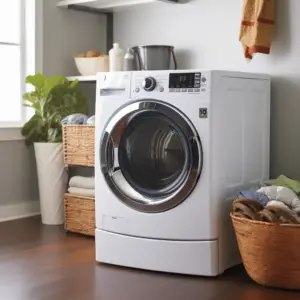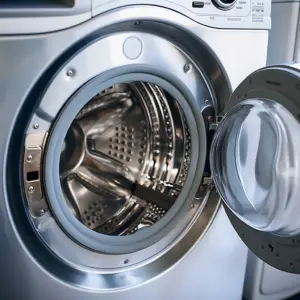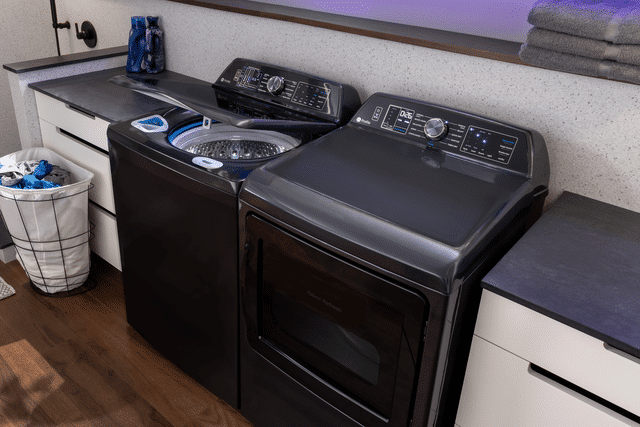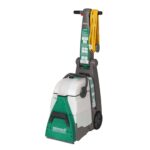GE Washer Spin Issues are reliable and durable. However, sometimes, even the best model will require some repairs, especially with the continued use of the washing machine.That might make you worry about the Ge washers, but the fact is they are of high quality, and you deserve to have one.
Even if they malfunction at some point, they are very easy to repair. This guide will help you know what makes your GE washer not spin and how you can fix them.
The most crucial phase of every washing machine is the spin cycle. If the spinning program works correctly, it will completely dry your clothes, leaving them fresh and ready to wear without leaving you too much work. Something needs to be fixed if your GE washer cannot spin the clothes, or it’s producing weird noises or shaking a lot.
You can effortlessly diagnose the issues that make your GE washer not spin. However, you should call a professional if you cannot do so or if the system is completely unresponsive.
Here is how you can determine the cause of your GE washer not spinning and also how you can troubleshoot each problem.
Table of Contents
Reasons Your GE Washer Is Not Spinning

Overloading or Underloading the Washer
A washer not fully stocked with laundry might become unbalanced and cycle incorrectly. It’s expected that an overloaded washing machine will have the same result. Of course, a washer loaded incorrectly may also make more noise or fail to start spinning.
Your GE washing machine may operate badly and malfunction if it’s overloaded. Therefore, only wash the recommended number of garments at a time since laundry control prevents costly and pointless damages.
Before filling up the GE washer, check your machine’s weight capacity. Armed with such knowledge, you’ll be able to comfortably fill the washer while keeping a close eye on the amount of load your washing machine is handling.
Load Imbalance
Load imbalance develops in your GE washer if one side is heavier than the other. Poor weight distribution prevents the washer from spinning.
It’s necessary to spread your clothing equally across the drum; otherwise, it won’t spin. An imbalance in the load might cause items to be flung around and bang against the inner wall while the machine is running. Load imbalance typically happens when users try to wash delicate fabrics quickly while using bulkyclothes or towels.
The load imbalance will stop the spinning because the program aims at preventing mechanical harm. The washer will even shut down and notify you of the issue. Before starting over again, you need to correct the load imbalance by opening the lid and spreading your clothes out.
Clogged Water Pump
There is usually a strong probability that the water pump is clogged if your washer won’t spin but still agitates. The water pump serves the role of spreading water throughout the wash and propelling the dirty water out of the drum as the washer engages in spinning.
The water must drain out of the drum completely before the washing machine may begin to spin. When water pumps are blocked, the washer won’t be able to initiate the spin.
The water pump in your washing machine could be the problerm if the washer is producing rattling noises or draining slowly. After unplugging them, check for obstructions, such as lint or laundry softener sheets.
The water pump must be changed if there are no obvious clogging indicators or damage.
Faulty Lid Switch
On top-loading washing machines, the lid switch is under the main lid. As a safety measure, the lid switch stops the machine from running when the lid is open. That is why you will realise in normal circumstances that your GE machine stops when the lid is raised.
You won’t be able to spin clothes or use your washing machine if the lid switch safety device malfunctions. When your GE washer won’t spin, try closing and reopening the lid first. If it doesn’t fix the issue, investigate if the lid switch is faulty.
If the lid switch is activated manually for the GE washer to spin, you must check the washer to determine if the levers or actuators are stuck or otherwise compromised.
Despite the fact that the lid mechanically actuates the motor unit of the GE washer, a faulty switch will make it unresponsive.
Replace the lid switch if the levers, actuators and the motor unit of your washing machine are not compromised.
Worn Out Drive Belt
If the drive belts in the top-load or front-load washer baskets are worn out, they won’t spin. These belts move your washing machine’s spinning basket.
Drive belts contribute to the rotation of the drum and regulate the action of the wash load and the agitator.
Your GE washer can fail to get into the spin cycle due to an extremely worn out belt. Squeaking or other weird noises might be an indicator that the drive belt is stretched, loose, or damaged, but you should also be aware of any sounds that point to a problem with the belt itself.
A trained repair person can quickly replace the worn-out drive belt. It’s time to repair your GE washer’s drive belt if the washing machine is too noisy and cannot spin.
The Washer Is In Need Of a Master Reset

You can either reload the washing machine that is not spinning or run another cycle. Another alternative is for you to empty the washer and perform a master reset.
Unplug the washing machine and open the lid to empty it. Close the lid and plug it back after it has sufficiently drained. Unplug the washer as you open and close the lid six times in 12 seconds to do a master reset. Each washer has a unique reset method.
If the fixes stated above don’t work, call a professional to help you correct the mess.
The Washer is Not Levelled
Your GE washing machine won’t function at its maximum capacity and efficiency if it isn’t levelled. Apart from the failure to spin, additional warning indicators to look out for if you think your washer may be unbalanced include excessive noise and vibration throughout the wash cycle.
Place the carpenter’s level on top of your washer to examine its level. Your machine must be levelled if you notice one endpoint higher than the other or an incomplete line.
Adjust your GE washer’s front and rear legs independently until the machine is perfectly balanced.


